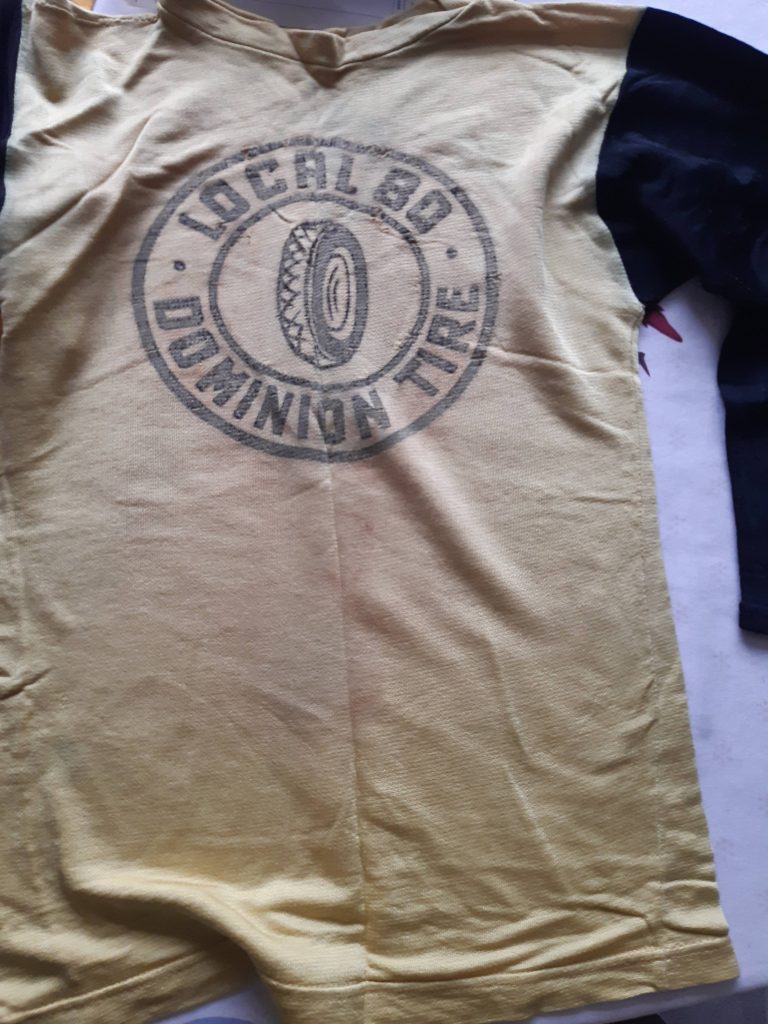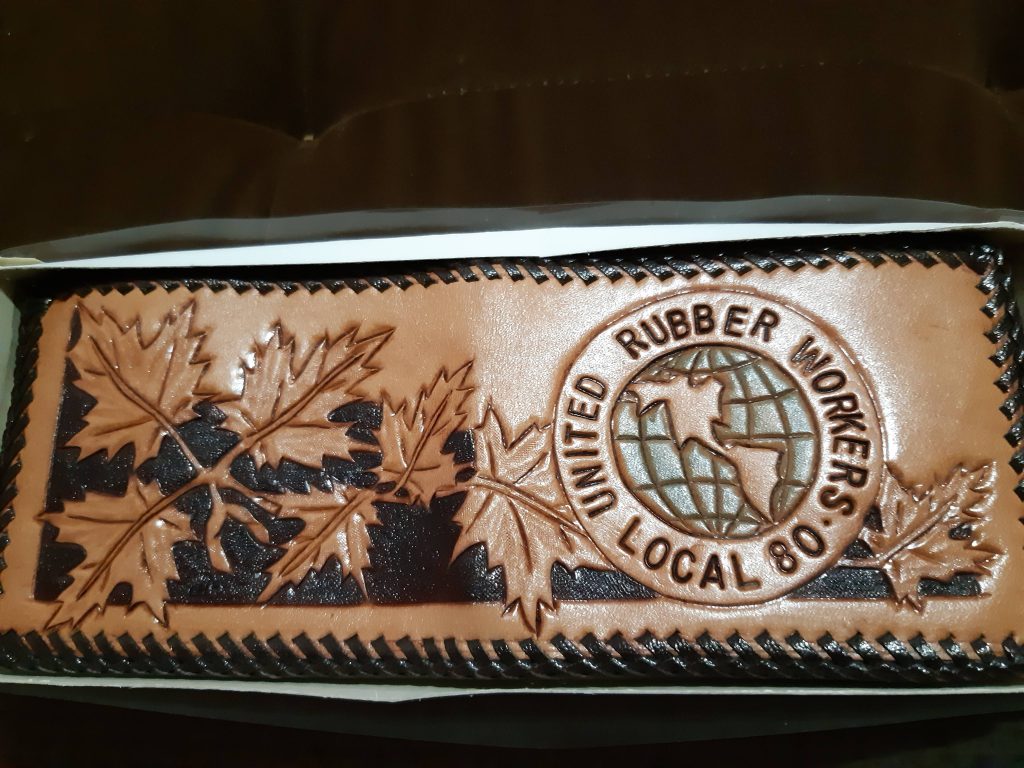This article is part of the series The Trials and Jubilations of Working in the Rubber Industry: Rubber Worker Storiesand is supported by the Region of Waterloo Arts Fund.
Do you dream of lifting 450 lbs. every five minutes? Would you enjoy an irregular work schedule that includes night shifts? Do you eagerly await the chance to blow black gunk out of your nose at home every day? I’m guessing not, and yet thousands of people in Waterloo Region took on jobs at rubber factories and tolerated these harsh working conditions in the 19th and 20th centuries.
What Kind of Jobs Were Available at a Waterloo Region Rubber Factory?
Rubber factories employed people in a myriad of jobs. Most of the participants I interviewed worked on the floor, either mixing the rubber compounds or manufacturing the tires.
Brian worked on the floor at Uniroyal on Strange Street in Kitchener from the 1970s until the factory closed in 1993. You got the “crappy jobs” when you started, but better jobs came your way the longer you worked there. If you transferred between departments, you started at the bottom of the hierarchy again in the new area.
Most of the work on the floor was manual labour, which injured the body over time. Brian was lifting 450 lbs. every five minutes. “I think I was lifting well over a million pounds a year,” he says. We spoke in 2019, and he was waiting for his third back surgery. As of this writing, in the summer of 2021, he’s awaiting his fourth, which will require two surgeons and take all day. In addition, Brian has had both hips replaced. He also expects to have both knees replaced in 2022.
Office jobs were also available. Eric, for example, worked on the mainframe computer at Uniroyal. This may be hard to imagine today, but the mainframe computer was the size of a van. It ran 24 hours a day, seven days a week and needed workers throughout. Office jobs came with fewer occupational hazards.
Working Conditions in Rubber Factories
Don S.* worked at Uniroyal only from 1980 to 1990. “You stand around and look at the old people operating machinery on a midnight shift and you realize, God, there’s gotta be a better way, because that man does not look happy.” He understood immediately the toll that this factory work took on each person’s body and began applying to college programs as soon as possible, working as many night shifts as possible to support getting an education during the day.
“Every part of your body ached after your shift,” says Brian. “It’s not that you weren’t in shape. It was so demanding.”
Wayne, who worked at the BF Goodrich plant on Goodrich Drive in Kitchener from 1971 to 1990, spent several of his early years building tires for tractors and large trucks. He found the summer especially difficult. “It was hard work, no question, very hot in the summer,” he says. “Lots of these great big guys were walking around that plant with a broom because they screwed up their backs, especially back in the early seventies.”
Wayne had to take time off about once a year because of his back in his early days. “But I was a young guy. Things heal and back you go.”
The factories were dirty in the 20th century. With poor ventilation and little or no personal protective equipment, workers were exposed to harmful substances, including carbon black, now acknowledged as a carcinogen.
However, things have thankfully changed over the years.
Part of the former Uniroyal plant is now home to AirBoss, a rubber compounder. Glenn, a current employee at AirBoss, began at Uniroyal in 1987.
“It’s more safety-oriented now,” he says. “We have to wear masks. Everybody wears eye glasses. Everybody wears hearing protection. The guys in compounding, they’ve got to wear masks and gloves, all the PPE.”
(Compounding is where the rubber is mixed with additives.)
In addition, ventilation in the factory has greatly improved. Dan, who used to work at AirBoss, says that every mixer has its own continually running ventilation hood, for example. Workers responsible for weighing out chemicals wear respirators and other personal protective equipment (PPE), too.
What Is Shift Work and How Did It Affect Family Life?

My grandparents worked at the Uniroyal factory on Strange Street My grandmother worked at the canteen, so she didn’t work at night, like my grandfather sometimes did. When we visited them, there was something I didn’t understand: Why did I always see my grandmother, but not my grandfather? All of my other grandparents kept predictable work hours, only my Opa Wolf didn’t. Sometimes he was home, sometimes asleep, and sometimes awake but in bed. Why?
It was because of his shift work: he didn’t work the same hours every week. At Uniroyal, the shifts ran from 7AM to 3PM, 3PM to 11PM, and 11PM to 7AM. The workers changed shifts every week.
My grandfather passed away shortly before I turned nine, so I couldn’t figure out a pattern to his inability to visit with us. My family was on a regular schedule: we slept and were awake at the same time every day. When we visited my grandparents, though, my grandfather’s schedule was different every week.
“It really destroys your clock,” says Brian. “It took me a long time to learn how to cope with it.”
Mark worked on and off at Uniroyal, finally leaving the year he turned 30. He had a love-hate relationship with shifts: He enjoyed working 7AM to 3PM, but found the other shifts difficult. With 3PM to 11PM, he would just get something started in the morning only to have to leave for work in the afternoon. Working 11PM to 7AM meant he missed out on partying with his friends.
“Eleven to seven was hard on your sleep pattern,” he says. “I would get home, and I just didn’t feel like going to bed. So, sometimes I’d be awake at ten, eleven in the morning, but it’s like, ‘Man, I got to get to sleep because I know I got to go to work at eleven o’clock at night.’”
Although the shift work was difficult to adjust to, some of the rubber workers I interviewed appreciated the schedule. Brian, for example, came to like it because it gave him more time with the kids. Jim, who worked at BF Goodrich for 32 years, didn’t mind the midnight shifts: he would sleep on a cot in the basement if he needed to. It was actually the afternoon shifts that bothered him, because they interfered with his Boy Scout responsibilities every three weeks.
Why Do Such Work?
It’s hard for me to fathom why anyone would take on such physically demanding and dangerous work. Other jobs existed: shopkeeper, sales clerk, welder, electrician, teacher, baker, mail carrier… Why would thousands over the decades work in such conditions? Based on these interviews, conversations with my family, and articles I’ve read in our local paper, people worked in these factories first and foremost because high wages made it easy to support families.
Don D.*, who worked at Uniroyal for almost 40 years, had been in the same house for 59 years when we spoke. Although his wife was teaching when they married, he also needed a good job to help pay off the mortgage on their $16,000 house. (That number is not a typo.) The $1.80 per hour or so he was paid at the rubber factory was an excellent wage when he started in the 1950s.
Wayne, who began building big tires as soon as he met the age requirements, earned $4.26 per hour in 1972/73. The work was gruelling. However, he and his wife had two kids and a mortgage, and the pay was good in comparison with anything he could have earned elsewhere. “It was a good time to be a young person looking for a job with no education,” he says.
What did he mean by “no education”? Before December 20, 2006, it was legal to leave school after Grade 10 in Ontario.
Although supporting a family was the main reason for many to work in these factories, other factors also played a role.
It Was All in the Family
Getting a job at a factory was relatively easy compared to getting a job today: You just had to know a family member who worked in a factory, and it didn’t even have to be your own family.
“I can remember bulletins on the doors saying, ‘If you know any brothers or cousins or anybody needs a job, send them in,’” says Wayne. “I can remember there was a whole bunch of these guys from up around Killaloe (Renfrew County), somewhere in that area. One of them came and got a job building truck tires. He was a big guy, and before you knew it, there were about 10 or 12 of them.”
Here are more examples from the oral history project participants:
- Jim’s mother worked for BF Goodrich, Kaufman Rubber, and Merchant’s Rubber.
- Mark’s dad eventually reached plant superintendent, and Mark’s uncle and two brothers also worked at the same plant.
- Wayne said it was common for young family members to get summer jobs on the floor or in the office: “When they said their name, you knew who it was.”
- Brian’s father-in-law retired from Uniroyal in 1989 after 44 years in service.
- Eric’s wife worked at Goodrich, and her father and uncle worked at Uniroyal.
Friendships That Lasted a Lifetime

The constant search for more workers meant that if you wanted to stay, you were almost guaranteed a job for life. This meant turnover in the factories was low, and fellow workers became long-time friends, and friends became like extended families. Workers formed baseball and hockey teams, and occasionally, an employee like Brian would step up and head an entire league, arranging schedules and ordering uniforms and equipment.
The factories were big, so the leagues were all in-house. The men didn’t always wait for a scheduled game. They brought in their balls and gloves, or hockey sticks and pucks, and played catch or shot pucks throughout the factory. As long as the machines were running, most supervisors were fine with it.
The BF Goodrich plant had enough land for its own diamond out back. “I don’t know the exact number,” says Wayne, “but it was close to 90 percent of the people who worked in the factory played in the company baseball league.”
In addition, the foremen at BF Goodrich organized themselves into the KW Foreman’s Association. They met monthly and invited guest speakers. They eventually built the Foreman’s Club in St. Agatha, which ran for about 25 years before closing.
The office employees, too, had their social activities. At Uniroyal, for example, they formed a baseball team, would often go out on pub crawls, and frequently ate lunch at Mabe’s, a greasy spoon across the street.
“Absolutely the place to go for lunch,” says Eric. “People will remember Mabe’s. It was a wonderful, greasy place. They don’t make them like that anymore.”
Waterloo Region’s Rubber Factories: Work That Supported Families

I had some difficulties, though, reconciling the gruelling work conditions with positive comments about the work.
“I enjoyed working in the tire factory,” says Jim. “If it was still going, I would be there. It was like a family, kind of.” He adds, “I was lucky at the end, for the last five years. I was on the executive of the Foreman’s Club.” When the club closed and its building was sold, the proceeds from the sale were added to BF Goodrich’s endowment fund and managed by the K-W Community Foundation.
Wayne says many former employees are living comfortably in retirement: “Many of those people, including me, are living today pretty comfortably on a defined benefit pension.”
Brian says it was good to work in a factory in Kitchener at the time—any factory. “You were proud of it. Everyone felt they made the best product.”
Family, friends and pride. Three important parts of a good life.
*Two participants in the oral history project were named Don and had last names that began with the same letter. So, I’ve used letters from the ends of their last names instead to differentiate between them in these articles: Don D. and Don S.
Hi Lori. I was trolling the web in search of former Uniroyal Goodrich employees I had worked with and stumbled on your page. I found it interesting. I had worked at both plants and retired from BFG in 2005. Thank you for an interesting read. I just wish I could find some friends from my past. Thank you. John Dieks
Hi, John. Thank you for your kind comments. There’s a group on Facebook for BFG workers. You can also try the Facebook group “You know you’re from K-W and environs.” Hugely active, and you might have some luck there.